#Bedouin Tents
Text
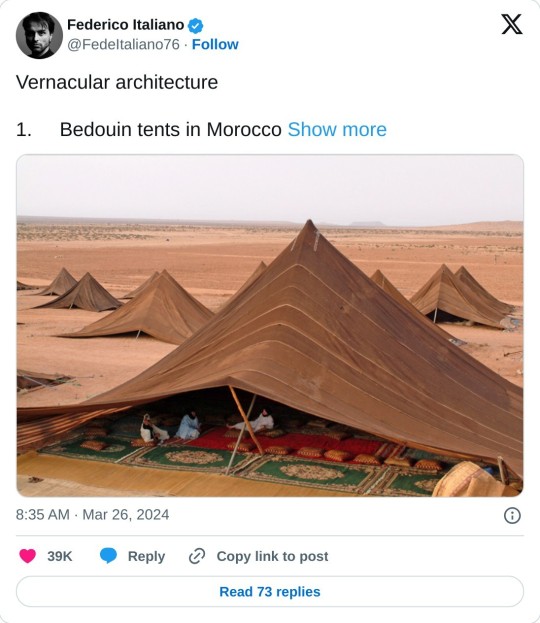
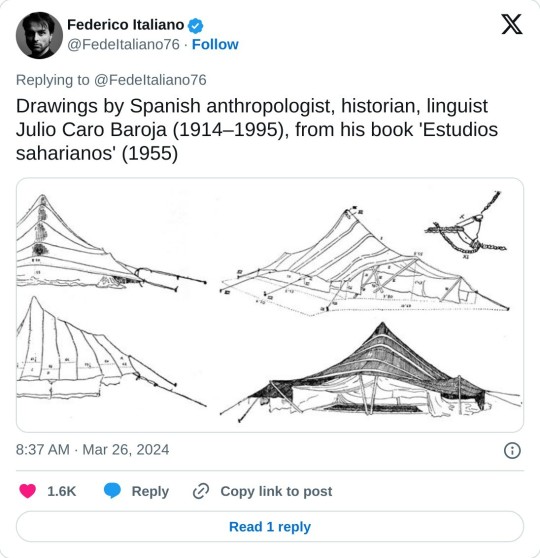
1 note
·
View note
Text
Roman Theater, Souks, Eid al-Fitr Amman Jordan

View On WordPress
#Amman Citadel#Amman Farmers Market#Bedouin Craftsman#Bedouin Tents#Egyptian Pharaoh Cleopatra VII of the Ptolemaic Dynasty#Eid al-Fitr Festival of Breaking the Fast#I&039;tikaf#Jabal Al-Jofah#Jordan Folklore Museum#Jordanian Museum of Popular Traditions#Nour al Barakah#Philadelphia Capital of the Roman Empire#Ptolemy Philadelphus#Ramadan#Roman Amphitheater Amman#Roman Emperor Antoninus Pius#Roman Triumvir Mark Antony#Souk el-Khodra#Souk el-Sagha#Souk Jara#Souk Mango
0 notes
Text
"Good morning Gaza,
get up, drink my coffee, and rise.
Our funeral has arrived.
Good morning Gaza,
get up and recite
the verse of return
to a land we have carried
like a tattoo on the hand.
Good morning, you stranger to your house.
Not all God’s earth is Rome
even if your flesh is a window-shop
for the masters of words. Your flesh,
is it Christ’s brittle bread?
Good morning, you offering on the altar of the Mediterranean basin,
cut your path short. You’re a prayer rug for idolators,
a cave of ancient civilizations, a tent for bedouin rulers,
you’re the armor of the poor and the alms of millionaires.
They auction you as surplus to the market’s demands.
And you are the dream of Palestinians on the streets,
a river of bodies in one.
Good morning Gaza. Get up. Gather your one arm. The one you have left.
Good morning Palestinian flesh on the tables of ministers and presidents.
You’re a stone
of solidarity and balance
among your executioners.
Not even your language protects you, so take a short cut.
Your flesh legitimates the police and the saint,
they swap names, take turns, merge, bond, and sometimes split
into two kingdoms that war over you,
but when you rise,
they reunite over your flesh.
You’re the geography of chaos, the history of this East, so take a short cut.
You’re a field of experiments for both heavy industry and light.
An encyclopedia of gunpowder, from the age of the catapult to the rage
of missiles that were manufactured in the West.
Palestinian flesh, in tribal nations and suited states
that disagree over the price
of potatoes, leather shoes, beets, crude oil, but agree
on expelling you from your blood,
gather in one arm,
gather as one, and write
the verse of return."
-Mahmoud Darwish
57 notes
·
View notes
Text
[ 📹 A Palestinian's car burns in Al-Lubban Al-Sharqiya, south of Nablus in the north of the occupied West Bank, as a result of attacks by Israeli colonial settlers on Wednesday night, while another similar attack occured in Al-Mughayir, to the east of Ramallah.]
🇮🇱⚔️🇵🇸 🚙🔥 🚨
ZIONIST SETTLERS CONTINUE ATTACKS ON PALESTINIANS WHILE ISEAELI OCCUPATION FORCES BURN DOWN A HOUSE WITH TEAR GAS
Israeli colonial settlers continued with their nightly attacks on Palestinian towns and villages across the occupied West Bank of Palestine on Wednesday and into the night.
In one example, Israeli colonial settlers burned the vehicle of a Palestinian family in the Al-Lubban area on Wednesday night, south of Nablus, while another, similar attack by settlers occured in Al-Mughayir, east of Ramallah.
In another violation, Zionist extremist settlers seized the tents of Bedouin residents in the Arab Mlihat community, in the Al-Ma'rajat area, to the northwest of Jericho, while also grazing sheep on Bedouin lands at gunpoint.
According to the General Supervisor for the Al-Baidar organization, which works to protect the rights of the Bedouin community in the occupied Palestinian territories, by the name of Hassan Mlihat, told Palestinian news outlet, WAFA News, that Israeli colonial settlers, backed by personnel belonging to the so-called Israeli "Civil Administration," which raided the Arab Milhat community; gathering and confiscating equipment for three Bedouin tents owned by local Bedouin resident, Musa Suleiman Mlihat, who also told WAFA that he witnessed at least one colonist grazing sheep among the local homes while wielding a gun.
In another Zionist attack, armed Israeli colonial settlers raided an archeological site known as Tal Ma'in, located to the east of Yatta, south of Hebron, in the southern occupied West Bank.
According to local reports, several colonists from the illegal colonial settlement of the Avigal colony, located on stolen and occupied Palestinian lands to the east of Yatta, raided the archeological site of Tal Ma'in to perform Talmudic rituals as an act of provocation, all while under the protection of the Israeli occupation army.
In yet another Zionist assault, Israeli occupation forces (IOF) launched several tear gas canisters at Palestinian homes in the town of Beita, south of Nablus, in the northern West Bank, resulting in the break out of a fire in one of the Palestinian homes.
According to local sources who spoke with a WAFA News reporter, several Israeli occupation military vehicles stormed the village of Beita in the evening, after which, Zionist soldiers began to fire bullets, stun grenades and tear gas canisters in the direction of Palestinian residences, one of which caused a fire to break out and burn part of a house.
The sources said local civil defense crews responded to a call about the fire, rushing to the scene where they managed to get the fire under control.
#source1
#source2
#source3
#videosource
@WorkerSolidarityNews
#israeli settler violence#israeli settlers#israeli colonial settlers#israeli colonialism#israeli crimes#israeli violence#israeli crimes against humanity#crimes against humanity#palestine#palestine news#palestinians#free palestine#occupied palestine#occupied west bank#west bank#gaza#israeli occupation forces#occupation#israeli occupation#israel palestine conflict#politics#news#geopolitics#world news#global news#international news#war#breaking news#israel#current events
20 notes
·
View notes
Text
by Khaled Abu Toameh
The first wave of Hamas's attack hit a music festival at Kibbutz Re'im which had an estimated 3,500 young people in attendance.
The magnitude of the onslaught became apparent as bloodied and panicked people staggered into the medical tent screaming for help.
Finally, the medical staff was ordered to flee along with everyone else.
Awad Darawshe, 23, an Arab-Israeli paramedic, remained behind, refusing to abandon the wounded. "I speak Arabic. I think I can manage," Darawshe said, supposing that he could reason with the terrorists. Perhaps he thought they would not harm a fellow Muslim Arab. He was wrong.
Hamas mercilessly beat, humiliated, abducted, and murdered their fellow Muslims, including Darawshe as he was bandaging the wounded. After Darwashe was murdered by the Hamas terrorists, his ambulance was stolen and driven into the Gaza Strip.
Abed al-Rahman Alnasasrah, 50, was murdered by Hamas terrorists when he attempted to rescue people from the music festival. He was married and a father of six children.
Fatima Altallaqat, 35, from the Bedouin village of Ar'ara, was also murdered while working with her husband near the city of Ofakim in southern Israel. She was a mother of nine children, the eldest nine years old and the youngest six months. Her brother said that Hamas terrorists shot 40 bullets into Altallaqat.
Her husband, Hamid, recounted:
"We're a religious Muslim family and she wore the traditional headdress of a devout woman. It is inconceivable they [Hamas terrorists] could not see who was inside [the car]. They were five meters away from her as they passed. She said she could not feel her legs. Her head was opened and I could see her brain. I knew she was close to death."
41 notes
·
View notes
Text
THE TREK ACROSS AMERICA WITH TWO STRAIGHT EGYPTIANS
Arabian Horse World
"On April 16, 2021, Patrick Sullivan of Modern Day Horsemanship started his 2,500 mile journey from Sacramento, California to Georgetown, Kentucky, where he arrived on October 16, 2021.
He took two Straight Egyptian Arabian horses, the black mare Gamilah MJA, sired by Bellagio RCA, out of the Thee Desperado+ daughter, Thee Bahieh, and her maternal brother, grey gelding Haleem MJA, sired by Thee Infidel, out of Thee Bahieh.
He did this incredible trek bridleless and mostly bareback, and visited 20 non-profits, local rescues, and charities while providing liberty demonstrations along the way.

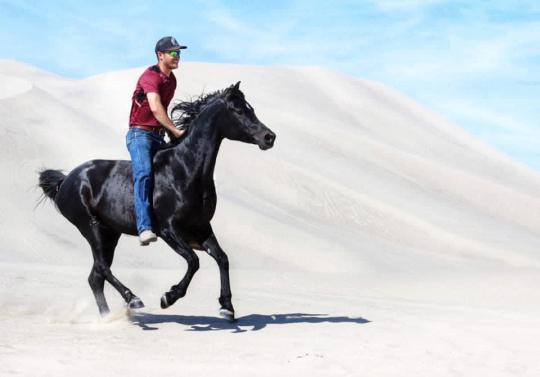
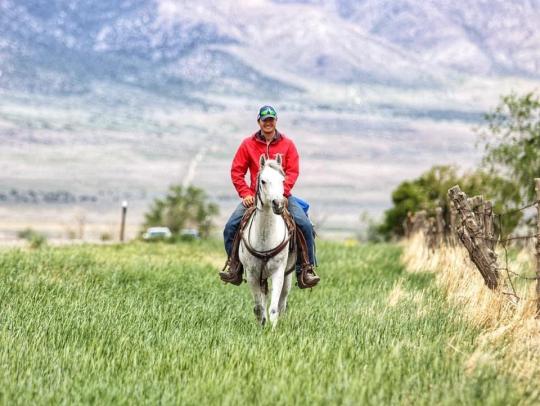
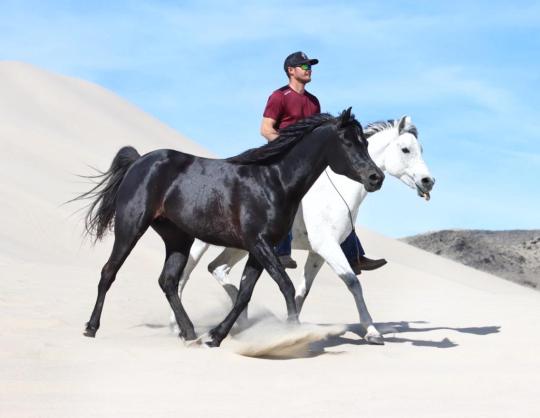


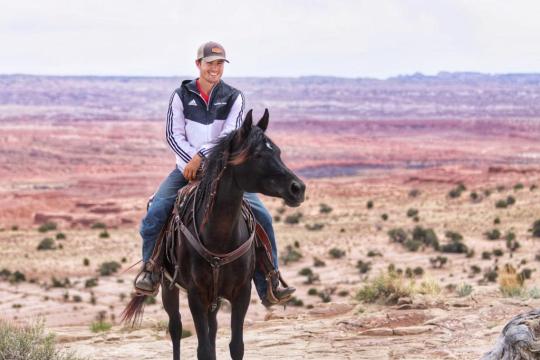
Shawn Crews sat down with Patrick to revisit this incredible journey.
Shawn: I’ll never forget the day when you told me your plan to do this, and honestly, Patrick, I know your whole family and I come from a very optimistic family, however, I considered your level of optimism to be triple of what I know. I’ve known you since before you were involved in horses. Your goal is so large and you have such a positive attitude, but still when you told me about this we were shocked. We are all very horse show goal-oriented, so I was curious as to why you chose to do something so different with your Straight Egyptian.
What was the seed that led you to this tremendous adventure? How did you come up with this plan and was was the vision you had in mind?
Patrick: You were not the only one who thought this was a bit crazy. This idea started six to seven years ago, and started when my mother told me that my great grandfather saw his first Arabian horse in the Chicago state fair in 1945 and fell in love. He ended up purchasing a few horses, however after him, they got out of Arabians until my mother got involved through Arabians Limited and you (Shawn Crews). The idea of this ride was to honor my great grandfather and ride from Texas to the location of the Chicago State Fair where my grandfather’s love began. Slowly the ride transformed into something much bigger, hoping to inspire people to think deeper about the Arabian horse and the connection we can have with them through liberty and bridleless riding.
I have read many historical books like The Classic Arabian Horse by Judith Forbis, and the Authentic Arabian Bloodstock books about how the Arabian horses lived in the tents with the bedouins and were treated as family. I wanted to test that legend out and bring our Arabian horses into our family. I want to really feel and say that these horses are exactly what history says. For me, the way to do this was to ride across the country with them and see if it is possible.
It was a long and amazing journey, one that I will cherish forever.
Shawn: No one in our time here has proved these horses’ athletic abilities until you and Gamilah. Did Gamilah inspire your plan to do this, or did the plan come first?
Patrick: It was a little bit of both. The reason I chose Gamilah to be the main instrument in the journey is because she was the first horse I had started under saddle. She was strong, opinionated and sassy. She is incredibly intelligent and we butted heads for years, however, the more I learned to listen to her and train her in the way she wanted to be trained, the more she wanted to give me. Once we came to that agreement, I knew there was no other soul on this planet that I would want to make this trip with than Gamilah. At the end of the day, I have always told people that I trusted her with my life. I knew she would keep me safe and keep herself safe; We went through so much together. I told her, if we are going to do this, we are going to do it together.
When I think about mares, especially the Arabian mares, I know they can be very difficult at times to earn their trust and respect, a lot more difficult than the geldings. However, when you get to reach the heart of a mare, they will do anything for you.
Shawn: How old was Gamilah when you started this ride?
Patrick: She was 10 years old. We left two days after her birthday.
Shawn: Tell me about the logistics of this trip. Nettie followed you with the trailer, so you always had a safety fall back should you need anything, and you had host farms set up along the way. However, there must have been long stretches along the way without lodging. That is a lot of miles, many of which are not civilized, explain the logistics.
Patrick: Nettie is one of my best friends in the whole world. Initially, she was going to ride with me. However, three months before, she called and said that she was pregnant and couldn’t ride alongside. So, they decided that she would drive the truck and trailer with her camera and document the journey.
We followed HWY 50. For the most part, the highways had a large shoulder which allowed them to stay 30-40 feet off the road, while the smaller roads we were right alongside. I kept panels on the side of the trailer and each night, we would set up a 20′ x 20′ pen behind the trailer where the horses stayed while we slept in the living quarters of the horse trailer.
So many wonderful people stopped along the way were offering assistance, and inviting us into their homes and barns to layover. It was amazing to experience the generosity of the people, stopping to be sure we were okay.
The best part of the ride, in regards to logistics, were the western states of Utah, Nevada, California, and Colorado. It was more open and had so much public land. The terrain was difficult and at one point, we rode up to 11,000 feet in Colorado. As we ventured East, the logistics became a bit more of a challenge.
We went through mountains, deserts, valleys, small towns, fair grounds, rivers. We went through it all!
Shawn: As the ride progressed and word spread, you seemed to gain momentum with the local press.
Patrick: Yes, honestly the ride was amazing, but the most important part of this ride for us was being able to give back to the Arabian horse. We ended up stopping at 19 different non-profits in 11 different states. We would educate them about liberty riding and use our horses to showcase how capable the Arabian horse is, and how powerful the horse-human connection is.
We stopped by non-profits for kids, for the mentally ill and even a prison to educate the prisoners on horsemanship. Our horses were able to teach all that we visited and that was so rewarding. These organizations helped us get through the long days, knowing that our next stop was going to help and educate the next group of people about our Arabian horses and their amazing personalities.
Shawn: You have mentioned the liberty aspect of this ride a few times, can you explain a bit about what liberty means.
Patrick: Liberty is being able to do almost anything with a horse without a halter. Express to your horse what you want it to do, without a bridle or halter. The relationship between horse and human, along with trained cues is the key to create a bond. I often relate to the movie Avatar, if you have the ability to connect with another being, in this case being a horse, they can take us to see things that we could never do on our own. Gamilah and Hal gave me this experience along our journey.
Shawn: Did you feel a bit like those pioneers that crossed the country so many years ago in their covered wagons?
Patrick: One of the main parts about the trip (possibly 1,000 miles), we followed the Pony Express Trail. The pony express was used as a form of communication across the country long before technology. I learned how incredibly strong people were back then. Their lives revolved around horseback, compasses and reading the stars. From time to time, I liked to think that we were the new generation of explorers, experiencing what our ancestors had. Hoping to push the next steps in horsemanship and prove that the Arabian horse is one of the foundation breeds of our country.
Shawn: I have great respect for all Arabian horses, however, my life has revolved around the Straight Egyptian Arabian horse. Are there any special traits to the Straight Egyptian that you feel helped in this experience? Knowing that you have experience with other bloodlines and other breeds, what made the Straight Egyptian special?
Patrick: I’ve never met another horse that could have made that trip, and there is no other horse I would attempt to do it with. What I feel separates the Straight Egyptian is their heart. If you really look at the heart, they are old souls. They seem to be here to teach us, and I believe this comes from their ancestors. I truly believe the Straight Egyptian is the old soul of all horses. When I look in Gamilah’s eyes, I see that soul and it has taught me so much!
There are good things and bad things said about the Straight Egyptian Arabian horse. For anyone who has ever truly gotten to know one, I think can relate to what I am saying.
Shawn: In this project, you have mentioned Nettie being an amazing support, along with your family and a group of sponsors that helped make this possible.
Patrick: I think those who supported us are what made this trip so special. There was not a bigger supporter than my mother, Malinda Passmore. she is all about the Straight Egyptian and wants to make it accessible to everyone, especially the geldings. Our other sponsors were Marah Jamil Arabians, Keri and Carolee Wright, Ann and Fred Gabrielli and The Pyramid Society,
There was one of the biggest professionals in the horsemanship industry that I am friends with. He is not an Arabian horse person, but he told me, “I don’t have a problem with you riding across the country brideless. I don’t have a problem with the time frame or liberty. My biggest concern is that you are doing it on an Arabian!”. This comment inspired me to prove the Arabian stereotype wrong. I will keep his name anonymous out of respect for our friendship, however, I was quite proud to show the world that the Arabian horse can do anything."
35 notes
·
View notes
Text
Within days of Hamas’s massacre last month that left 1,400 people dead in Israel, a gas station near the southern city of Be’er Sheva was packed with Israeli soldiers. Convoys of beaten-up military jeeps were zigzagging in and out of the pump terminals, and the roadside cafe had stopped taking civilian orders, trying to reserve all available stock for troops preparing for the first ground invasion of the Gaza Strip in just under a decade. In the parking lot, Israelis manned a makeshift booth offering falafel to passing soldiers, playing patriotic songs. The gas station workers, meanwhile, leaned on stock pallets in a shaded corner—four Bedouins speaking to each other in broken Hebrew with thick Arab accents, staring out into a nation not quite their own on the brink of war. They must have been terrified of outing themselves as Arabs.
By the end of the 1948 Arab-Israeli War, there were roughly 156,000 Palestinians who found themselves within what became the official borders of the state of Israel. Almost overnight, they had morphed into citizens of Israel. As of 2020, they number almost 2 million (including East Jerusalem Palestinians who hold permanent resident status), comprising about 20 percent of Israel’s population. They had evaded exile, but their initial relations to the state were marred by resentment and confusion: Many had relatives settled in tent cities in neighboring Arab countries, and large swaths of their former agricultural lands had been expropriated. Almost two decades would pass until these Arab towns in Israel would be released from military rule.
Arab citizens began from a point of severe disadvantage. Much of the Palestinian population lived in farming communities with lower levels of literacy. On top of this, there were deep feelings of resentment associated with the establishment of Israel and the new necessity of navigating it in what then was the enemy tongue.
More than half a century later, these Arabs are intimately embedded in the fabric of Israeli life. All signs indicate that, over time, socioeconomic gaps have narrowed. Scarcely a single sector can function without Arab labor. Schooling and the domestic life of Arab Israelis are still largely conducted in Arabic, and members of this population tend to gain fluency in Hebrew only upon entering higher education. In academia, most material is taught in Hebrew, and then, in most professions, Arab Israelis invariably sit alongside Israeli Jews on a daily basis.
A degree of accommodation and understanding has formed, and as far as many Israelis are concerned, this is the gold standard of coexistence. Arabs, however, continue to face discrimination and hardship—along with their own internal divisions.
What am I? Too Israeli for the Palestinians and too Palestinian for the Israelis. Our identity is no identity, and we are born into confusion,” said Huda, an office worker who lives in the northern town of Kafr Yasif (she did not want her last name used because she is scared of reprisal).
Huda is a Christian Arab. Christians make up 1.9 percent of the Israeli population, while Muslims comprise 18 percent, and Druze, 1.6 percent.
This confused identity becomes more acute during times of war. “Unlike Israeli Jews, I hear the screams of Palestinians in my mother tongue and I understand them,” she said. “And yet, here, understanding them amounts to sympathizing with them.” (Interviews with Arab Israelis for this piece were conducted in Arabic and Hebrew, depending on the subject’s personal preference.)
Since the outbreak of the war, at least 110 Arab Israelis have been arrested for speech-related offenses, according to Adalah, the legal center for Arab minority rights in Israel. Separately, the group said 100 complaints have been filed against Arab Israeli students, 74 have been summoned for disciplinary hearings, and three students have been expelled.
Abed Samara, head of the Hasharon Hospital cardiac ICU in central Israel, was suspended from work for a Facebook post published roughly two years ago featuring a green flag with religious writing in Arabic and a dove symbolizing peace, along with a short text in Arabic that included the word “martyr.” The color green is traditionally associated with Islam. Samara said the flag was mistaken for the Hamas flag and the post was deeply misconstrued. “No one even bothered to consult me about any of this,” he said in an interview given to Hebrew-language media.
Dalal Abu Amneh, a popular singer and neuroscientist, was arrested and held in solitary confinement for two nights for posting a Palestinian flag with the caption, “There is no victor except for that of God.” These are just two examples of Arab Israelis who have had their reputations ruined after the events of early October—despite the fact that a recent poll showed at least 80 percent of Israel’s Arab population to be categorically against the massacre.
Fighting between Israelis and Palestinians in the West Bank and Gaza does not usually trigger violence between Arabs and Jews in Israel. But it did the last time Israel and Hamas fought a war in May 2021. Among the attacks on Jewish Israelis, synagogues were torched and hundreds of homes were looted—many of them in and around mixed Arab-Jewish cities.
The incident shook Israel enough that its military a few months later staged an exercise simulating scenarios of “domestic unrest” for the first time since the Second Intifada. On Oct. 4, just three days before the massacre, an Israeli headline featured talks among police officials to loosen open-fire protocols. As of Oct. 26, that motion has been set forth for voting in the Knesset and comes as Israel is especially attuned to signs of sympathy for Hamas among Arab Israeli citizens.
“I woke up that Saturday, saw footage of the massacres, and my first thought was: We’re done for,” said Hamada Mahamid, a 30-year-old Hebrew teacher from the Arab Israeli city of Umm al-Fahm, the third-largest Arab Israeli city and part of a cluster of exclusively Muslim towns and cities bordering the Green Line. “It was clear to all of us that this is no joke: People are holed up in their homes, my friends have stopped going to work, and we are even reluctant to chat over the phone,” he said.
Similar sentiments were expressed by Arab Israeli politicians, who currently number 10 of 120 members of the Knesset. Even those who have generally assumed staunch positions against Israeli military operations in Palestinian territories, such as Ahmad Tibi, have urged their populations to keep a level head and avoid any actions that may risk their standing in Israel.
Hosni Sadeq, a restaurant owner from the Arab Israeli city of Tira, said he feels betrayed. Even during the quietest periods, a stabbing attempt on the other side of the country would leave his restaurant empty on the busiest day of the week—which tends to be Saturday, when Jews stream into the local marketplace for shopping and authentic Arab food. “Not only do I have to speak their language and never with a single mistake, but I have to forget my origins and never speak a word about their enemies,” he said.
For Huda, war exposes the wedge between the two peoples living on a single slice of land, which each side claims as its own. “We are not actually friends,” she said. “We exchange laughs at work, but when war breaks out, each rushes back into his own camp.”
Crime rates in Arab Israeli towns have skyrocketed in recent years. The Israeli police blame a lack of cooperation from Arab citizens for the inability to reverse the trend, but Arabs often cite a lack of initiative on the part of the authorities. “Just like in America, but a little different,” Mahamid said. “Here, no one cares when Arabs kill Arabs—if anything, it serves the state well.” Israeli politicians often refer to the danger of Arab violence seeping into Jewish communities— which Tibi called “condescending,” as it paints the Arab community as the “backyard” of Israel, where “anything can happen.”
Indeed, several months ago, Israeli Police Commissioner Kobi Shabtai was heard on a leaked voice recording shrugging off the endemic violence, in a conversation with right-wing extremist Itamar Ben-Gvir, Israel’s national security minister. “There is nothing that can be done,” Shabtai said, according to reports. “They kill each other. That is their nature. That is the mentality of the Arabs.”
Now, as the Knesset is being called to vote on loosening open-fire protocols, calls among Israeli Jews to establish armed community-watch squadrons, and Arab officers in the police force languishing at just above 5 percent, Arabs are convinced that the police will never truly be on their side. Many have begun rethinking plans for the future.
Mahamid, who plans to marry in a couple of months, is for the first time looking into immigration options.
“The last decade of quiet is dead and gone—everyone knows it, even though some deny it,” Mahamid told me, echoing the words of Israeli National Security Advisor Tzachi Hanegbi, who, referring to Hamas in a recent address, said that “all of the terms of the past are gone and have dissipated.” Hanegbi’s words apply as much to homeland security as to the Israeli social fabric, which many Arab Israelis believe has been irreparably damaged.
“I condemn the massacre. I retched at the sight of what Hamas did. And I condemn the ceaseless bombing of innocent Gazans. If the Israelis didn’t know in advance about the massacre, how would the 2 million Gazans have known?” Mahamid said. “But when this is all said and done, we are going to be left alone with them here on the interior.”
Survivors of the massacre tend to note two things in recalling the horrors of that fateful Saturday: the sound of gunfire and the sound of Arabic. Almost every reference to that day includes a reference to the Arabic language, which as of 2018 was downgraded from an “official language” of Israel to one of “special status.” This shift came in the nation-state law, a controversial measure from the political right that sought to reaffirm Israel’s role as the “national homeland of the Jewish people” and left Arabs wondering what exactly they have been working toward over the last several decades.
“Canada is looking good at the moment,” Mahamid told me. “I can’t speak a lick of English, but I’d now prefer to babble than take my chances in Arabic on the Israeli street.”
20 notes
·
View notes
Text
Raja Shehadeh, from the chapter "Monasteries In The Desert: Wadi Qelt to Jericho," in "Palestinian Walks: Notes On A Vanishing Landscape."
"... we reached Fawwar spring. In Arabic the name means 'bubbling,' from the fact that this spring gushes and stops at regular intervals like a fountain.
As we walked away from the sound of the water and came to a quieter section I noticed that Rema, who is an anthropologist, was scanning the horizon. When I asked her if she was looking out for settlers she said she wasn't. She was missing the Bedouins whom she used to meet and chat with on walks in this area. She knew a lot about the kind of life they led in this canyon, where they had grazed their sheep for years. Now they had been chased away by the Israeli authorities. 'It is as though the life had been sapped out of these hills,' she said. Most accounts by travellers who have walked in this area describe how they were struck by the bareness of the hills surrounding the lush valley and the preponderance of the Bedouin shepherds roaming them. Now only the bareness remained.
I thought of the absent Bedouins as I walked. Theirs was a different vision of the land. They saw it as an integral whole. In the summer they pitched their tents over high ground where it was cool, and in winter they descended to the Ghor to reduce the likelihood of their newborn goats and sheep dying from the cold. In a country where there has been such a scramble over land they hardly ever bothered to register any in their name. How could they when they didn't concieve of it as divisible plots?"
#raja shehadeh#from my book collection#personal readings#palestine#palestinian literature#free palestine
13 notes
·
View notes
Text
I will proudly say that my favorite TES game is Morrowind, I picked it up last year and I'm madly in love with it, but I have always noticed the developers referencing some elements of middle eastern culture, whether it's the Ashlanders or the building itself, or something along those lines. Despite the presence and feeling of Hinduism in the game, I feel as though the middle eastern element is less discussed. Plus, I'm not a hindu, but someone from the middle of nowhere in Saudi Arabia, so I can't really say much.
so i decided to make this post, where i point out stuff i have noticed in the game and basically give myself an excuse to go "my video game mentioned my culture!!!!!"
lets start with an obvious one, moon and star.
moon and star is the ring that is given to you by azura, and its also the logo of the game. and wouldnt you know, its one of the symbols of islam, the Star and crescent
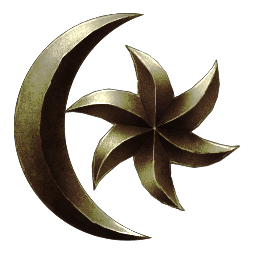
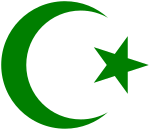
i also have this theory about how the ring is a reference to solomon's ring, i can kinda see it but im not 100% sure.
now for a part im surprised no one talked about, the quran page in one of the pages.
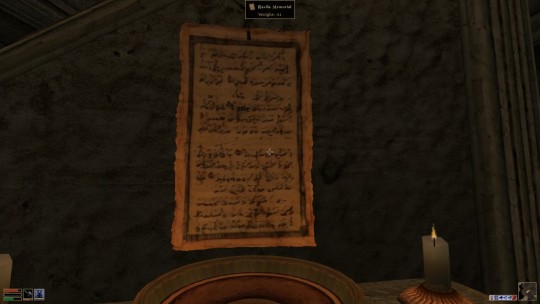

this part genuinely took me by surprise, out of all things i didnt expect to see a quran page here, the image i attached is not the exact page but its the closest i found and is mainly here for comparison. you can even see the lil circles where the numbers of the verse are supposed to be, i dont know how to access the texture so this is the best image i could find.
ashlander tent patterns

another screenshot i took, this time showing the insides of one of the ashlander tents, the patterns on the back look too similar to tent patterns you'd see in Bedouin tents, especially those from saudi arabia
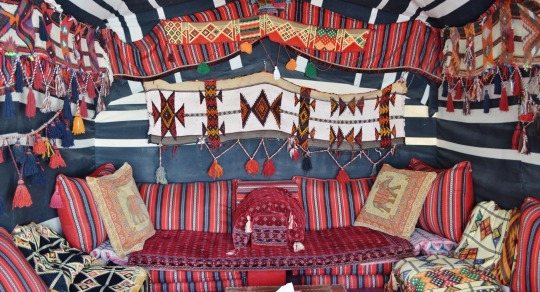
i just thought its cool how morrowind has taken a lot from different cultures, including mine, for world building. i love being able to recognize my culture in lore, i would mention eso but im kinda bummed on how it seems to lessen it? kind of? i havent played in years but from what i remember there was barely anything to drive home :/ oh well, i mightve forgotten some parts like how the architecture has inspiration from north africa and the arabic peninsula, or how ashlander names are taken from ancient Babylonian and Assyrian names, but i thought id make this post for funsies :)
#morrowind#tes#tesblr#the elder scrolls#middle east#middle eastern culture#this is a mess but i just wanted to get this off my head for the longest time
21 notes
·
View notes
Text

Der Sessel, der Würde verleiht... Vor ein paar Wochen habe ich im Beduinenzelt auf der Weseler Werft Märchen erzählt. Wer mich mal Märchen erzählen hören mag, kann das am Montag, 21. August 23 von 12- 13 Uhr auf radiox.de tun. Die Märchenoase präsentiert morgen Märchen von, mit, über das Wasser.
.
.
The armchair that gives dignity... A few weeks ago I was telling fairy tales in the Bedouin tent at the Weseler Werft (shipyard). Anyone who wants to hear me tell fairy tales can do so on Monday, August 21, 2023 from 12:00 p.m. to 1:00 p.m. CEST on radiox.de. The Märchenoase (fairy tale oasis) will present fairy tales from, with, about water tomorrow.
21 notes
·
View notes
Text
Good morning Gaza,
get up, drink my coffee, and rise.
Our funeral has arrived.
Good morning Gaza,
get up and recite
the verse of return
to a land we have carried
like a tattoo on the hand.
Good morning, you stranger to your house.
Not all God’s earth is Rome
even if your flesh is a window-shop
for the masters of words. Your flesh,
is it Christ’s brittle bread?
Good morning, you offering on the altar of the Mediterranean basin,
cut your path short. You’re a prayer rug for idolators,
a cave of ancient civilizations, a tent for bedouin rulers,
you’re the armor of the poor and the alms of millionaires.
They auction you as surplus to the market’s demands.
And you are the dream of Palestinians on the streets,
a river of bodies in one.
Good morning Gaza. Get up. Gather your one arm. The one you have left.
Good morning Palestinian flesh on the tables of ministers and presidents.
You’re a stone
of solidarity and balance
among your executioners.
Not even your language protects you, so take a short cut.
Your flesh legitimates the police and the saint,
they swap names, take turns, merge, bond, and sometimes split
into two kingdoms that war over you,
but when you rise,
they reunite over your flesh.
You’re the geography of chaos, the history of this East, so take a short cut.
You’re a field of experiments for both heavy industry and light.
An encyclopedia of gunpowder, from the age of the catapult to the rage
of missiles that were manufactured in the West.
Palestinian flesh, in tribal nations and suited states
that disagree over the price
of potatoes, leather shoes, beets, crude oil, but agree
on expelling you from your blood,
gather in one arm,
gather as one, and write
the verse of return.
—From “The Final Meeting in Rome” by Mahmoud Darwish, translated by Fady Joudah
(sourced here)
17 notes
·
View notes
Text
From “The Final Meeting in Rome” - Mahmoud Darwish, translated by Fady Joudah
Good morning Gaza,
get up, drink my coffee, and rise.
Our funeral has arrived.
Good morning Gaza,
get up and recite
the verse of return
to a land we have carried
like a tattoo on the hand.
Good morning, you stranger to your house.
Not all God’s earth is Rome
even if your flesh is a window-shop
for the masters of words. Your flesh,
is it Christ’s brittle bread?
Good morning, you offering on the altar of the Mediterranean basin,
cut your path short. You’re a prayer rug for idolators,
a cave of ancient civilizations, a tent for bedouin rulers,
you’re the armor of the poor and the alms of millionaires.
They auction you as surplus to the market’s demands.
And you are the dream of Palestinians on the streets,
a river of bodies in one.
Good morning Gaza. Get up. Gather your one arm. The one you have left.
Good morning Palestinian flesh on the tables of ministers and presidents.
You’re a stone
of solidarity and balance
among your executioners.
Not even your language protects you, so take a short cut.
Your flesh legitimates the police and the saint,
they swap names, take turns, merge, bond, and sometimes split
into two kingdoms that war over you,
but when you rise,
they reunite over your flesh.
You’re the geography of chaos, the history of this East, so take a short cut.
You’re a field of experiments for both heavy industry and light.
An encyclopedia of gunpowder, from the age of the catapult to the rage
of missiles that were manufactured in the West.
Palestinian flesh, in tribal nations and suited states
that disagree over the price
of potatoes, leather shoes, beets, crude oil, but agree
on expelling you from your blood,
gather in one arm,
gather as one, and write
the verse of return.
translated by Fady Joudah
16 notes
·
View notes
Photo
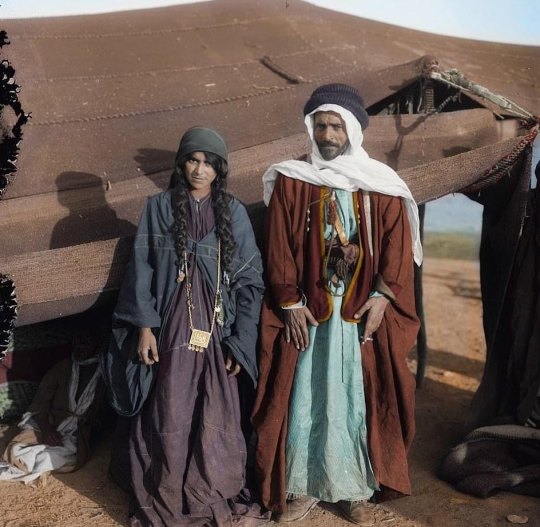
🔸 Bedouin couple in front of their tent, Adwan tribe. 1898. (Colorized by Frédéric Duriez). Area believed to be Jordan. #victorianchaps #bedouin #retro #jordan #arab #goodolddays #victorian #oldphoto #vintage #desert #nostalgia #1890s #colourised #adwantribe https://www.instagram.com/p/CnopkWlDN2r/?igshid=NGJjMDIxMWI=
#victorianchaps#bedouin#retro#jordan#arab#goodolddays#victorian#oldphoto#vintage#desert#nostalgia#1890s#colourised#adwantribe
54 notes
·
View notes


